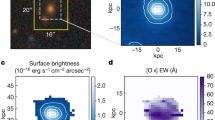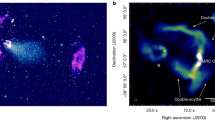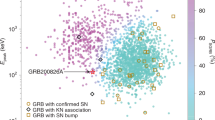Abstract
THE radio source G318.9 + 0.4 has been tentatively identified as a supernova remnant (SNR)1,2. Here I report observations at 843 MHz revealing a remarkable network of arcs in the object which exclude it from any of the standard classes of SNRs. The arcs outline an approximately elliptical region enclosing a bright off-centre core component which has several curved extensions. Although the appearance of the arc structures is unprecedented, G318.9 + 0.4 might belong to a recently proposed class of non-thermal axisymmetric radio sources unrelated to SNRs3. Alternatively, the core component may indeed be a SNR, excited by the stellar remnant of the supernova event, with the arc emission arising through jet activity.
This is a preview of subscription content, access via your institution
Access options
Subscribe to this journal
Receive 51 print issues and online access
$199.00 per year
only $3.90 per issue
Buy this article
- Purchase on Springer Link
- Instant access to full article PDF
Prices may be subject to local taxes which are calculated during checkout
Similar content being viewed by others
References
Caswell, J. L. & Haynes, R. F. Astr. Astrophys. 171, 261–276 (1987).
Broadbent, A., Haslam, C. G. T. & Osborne, J. L. Mon. Not. R. astr. Soc. 237, 381–410 (1989).
Becker, R. H. & Helfand, D. J. Nature 313, 115–118 (1985).
Mills, B. Y. Proc. astr. Soc. Aust. 4, 156–159 (1981).
Whiteoak, J. B. Z., Large, M. I., Cram, L. E. & Piestrzynski, B. Proc. astr. Soc. Aust. 8, 176–179 (1989).
Haynes, R. F., Caswell, J. L. & Simons, L. W. J. Aust J. Phys. Astrophys. Suppl. 45, 1–87 (1978).
Georgelin, Y. P. & Georgelin, Y. M. Astr. Astrophys. Suppl. Ser. 3, 1–49 (1970).
Lyngâ, G. & Hansson, N. Astr. Astrophys. Suppl. Ser. 6, 327–414 (1972).
Shaver, P. A. & Goss, W. M. Aust J. Phys. Astrophys. Suppl. 14, 133–196 (1970).
Shaver, P. A. Astr. Astrophys. 105, 306–312 (1982).
Green, D. A. Astrophys. Space Sci. 148, 3–74 (1988).
Velusamy, T., Kundu, M. R. & Becker, R. H. Astr. Astrophys 51, 21–24 (1976).
Clifton, T. R. et al. IAU Circ. 4422 (1987).
Kulkarni, S. R. et al. Nature 331, 50–53 (1988).
Manchester, R. N. Astr. Astrophys. 171, 205–215 (1987).
Helfand, D. J. & Becker, R. H. Nature 313, 118–119 (1985).
Hjellming, R. M. & Johnston, K. J. Proc. lAU Symp. 97 (eds Heeschen, D. S. & Wade, C. M.) 197–204 (Reldel, Dordrecht, 1981).
Author information
Authors and Affiliations
Rights and permissions
About this article
Cite this article
Whiteoak, J. Unusual radio arcs discovered in the radio source G318.9+0.4. Nature 347, 157–158 (1990). https://doi.org/10.1038/347157a0
Received:
Accepted:
Issue Date:
DOI: https://doi.org/10.1038/347157a0
Comments
By submitting a comment you agree to abide by our Terms and Community Guidelines. If you find something abusive or that does not comply with our terms or guidelines please flag it as inappropriate.



